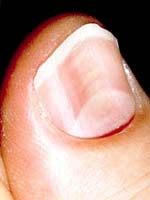What is koilonychia or spoon shaped nails
Koilonychia commonly called spoon shaped nails or spoon nails is a nail condition that can be a symptom of hypochromic anemia, particularly iron insufficiency anemia. It describes unusually thin nails, typically of the hands, which have missing their convexity, turning into concave with edges turned up. The spooning is usually such that a drop of water can be put and kept in the concavity within the nail. This shape can occasionally be found in healthy babies, however it goes away when the baby grows older.
The concavity is really in the nail bed, however because the nail is connected to the nail bed, the abnormality impacts the nails. In gentle cases of koilonychia, nails look like they might have a wavy surface. Sometimes the nail is separated vertically down the middle. Sometimes, the edges of the nails become flared and widen, the epidermis under the nail can get extremely dehydrated, damaged, or separated, and the hyponychium may become thick. This medical problem is usually not dangerous to patients, however it might be a sign of a more critical health condition.
Spoon nails causes
Acquired koilonychia, the commonest type, could be a result of damage, dermatologic conditions for example psoriasis, fungal bacterial infections, and reduced blood flow, or systemic condition for example iron insufficiency anemia. A typical appearance is in children who use too much stiff or poorly fitting footwear. Idiopathic koilonychia is the second most typical type and could be presumed after a careful lookup for a different cause. Inherited koilonychia, the least typical type. If this is the situation, several nails are going to be impacted with some type of concave dip.
The concavity is going to grow out, however the new developed nail is going to have the identical concavity. Koilonychia is a part of the nail patella syndrome, a hereditary health problem characterized by many abnormalities such as kidney disorder. Spooning fingernails could also be caused by damage, contact with some solvents, or it could be related to chronic health problems. Particularly, koilonychias is related to iron insufficiency.
Occasionally spoon shaped nails are because of a patient constantly picking, nipping, or stroking nails. If that is the situation, only the nails the patient has harmed are going to display signs of koilonychia. Serious damage to the matrix of the nail is also able to cause koilonychia. In such cases, only one nail is going to be damaged, so the patient will be able to recall the event when it occurred. A bad eating habits may also lead to spoon nails.
If a patients eating habits does not have iron, patient is going to be anemic. Patients could get this disorder in case the intestine is not appropriately absorbing the vitamins and minerals found in food correctly. Unusually, koilonychia is the consequence of a systemic condition, like lung or coronary disease or perhaps tumors.
Spoon shaped nails treatment
The treatment for koilonychia is going to vary for each patient. Dermatologist is going to look at the nail and obtain a patients medical history to establish the reason for the condition. The dermatologist could choose absolutely no therapy, realizing the disfigured nail is going to grow out, dermatologist could prescribe an iron supplement, or perhaps request additional lab tests to evaluate if there exists a deeper underlying cause. Treatment may additionally include an lotion that softens the finger nail or toe nail and the adjoining skin to stop splitting of the skin. Keep in mind that it is possible for harmful microorganisms to get jammed in the separate nail or perhaps in the open up, damaged skin layers.
Occasionally, accumulated harmful bacteria or fungus infection is going to change the region to yellow or maybe green. This disorder must be dealt with even in case the spoon shaped nails are caused by persistent rubbing, damage or picking of the epidermis beneath the area of the nail that is exposed and persistent coating with nail polish. Treatment options provided to replace missing iron have to be consumed no less than half an hour before eating a meal. Any kind of iron supplements provided to the patient by their family doctor have to be used precisely as recommended to avoid potential issues associated with the overload of iron and must not be used with beverages like green tea or coffee because these types of drinks are able to slow down the iron absorption.
Stay away from biting your fingernails because it might result in inflammatory reaction of the fingernails. Wear rubber work gloves if your job requires frequent use of fingers in fluid medium. Consume healthy food high in iron. Incorporate large amount of vitamins and minerals in your daily diet. If your kid gets anemic check with your physician for starting appropriate therapy. Decrease the consumption of coffee.
You may also like:
- Onychomadesis Causes and Treatment for Children and Grown Ups
Onychomadesis is the total loss of the nail without pain, onychomadesis is a sign of more difficult conditions, some people have recurrence of onychomadesis
- Onychodystrophy treatment and causes
Onychodystrophy is a word that represents malformation of nails. Treatment for onychodystrophy is characterized by the main reason behind onychodystrophy.
- Ingrown Toenail or Onychocryptosis Treatment, Surgery, Infection
What is an ingrown toenail, What causes Onychocryptosis, How to fix an ingrown toenail, Ingrown toenail home treatment, Onychocryptosis infection remedies.



